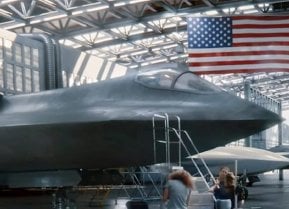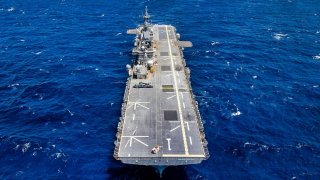Sea Control Ships: The U.S. Navy Light Aircraft Carrier That Never Sailed
The concept of a "Sea Control Ship" (SCS) has resurfaced over the years in the U.S. Navy's efforts to adapt its fleet to emerging threats.
Summary: The concept of a "Sea Control Ship" (SCS) has resurfaced over the years in the U.S. Navy's efforts to adapt its fleet to emerging threats.
Sea Control Ships: Key Ideas You Need to Know
-Initially proposed in the 1970s, the SCS was designed to provide air defense and anti-submarine warfare capabilities akin to World War II escort carriers.
-Despite the idea's failure due to bureaucratic and financial constraints, the notion persists.
-Recently, the U.S. Marine Corps has called for the development of smaller vessels for operations in the Indo-Pacific, reflecting the enduring relevance of adaptable, smaller carrier-like ships alongside traditional supercarriers.
The Sea Control Ship: A Naval Concept That Refuses to Sink
A rose by another name—the point of that oft-used phrase suggests that it doesn’t matter what we call someone or even something. Case in point, the United States Navy has those who continually try to reinvent a warship that existed before.
“Recently the Navy conducted a study of a concept called the air capable ship. Before the characteristics of the ship had been clearly identified, it was decided that the name should be changed from air capable ship to sea control ship in recognition of the new emphasis on this Navy role, stemming from the growing oceanic strength of the [a near-peer adversary]. This reflects an interesting change in the way we think about the Navy today because actually we have had a sea control ship for a good number of years—the aircraft carrier,” wrote Capt. Stephen T. De La Mater, USN, in an article for the U.S. Naval Institute.
De La Mater added, “Our treaty commitments with over 40 countries increasingly depend upon our control of the sea lines of communications with those countries.”
Those points are extremely valid today as the United States Navy faces a growing threat from China’s People’s Liberation Army Navy (PLAN), and it would be easy to assume that Capt. De La Mater was writing about the PLAN and Beijing’s interest in the Indo-Pacific, and how the U.S. Navy’s carriers fit into it.
However, those words were published not in May 2024, but rather fifty-two years ago in May 1972!
It was around that same time that the U.S. Navy began to consider the role of the so-called “Sea Control Ship” (SCS). As the Defense Media Network explained, the vessels were “designed to provide many of the same kinds of services as the escort carriers (CVEs—‘Baby Flat Tops’) of World War II.” Those vessels—essentially light carriers—were meant to serve alongside the larger supercarriers of the era, but couldn’t move beyond the bureaucratic infighting that existed in the sea service, while their anchor was the “double-digital inflation of the times.”
Though the Sea Control Ship didn’t happen, the U.S. Navy envisioned that it would have two primary missions that included intercepting and destroying Soviet maritime aircraft, and engaging in anti-submarine warfare (ASW). In the latter role, it would have employed targeting data from external sources, notably the SOSUS (SOund SUrveillance System), along with intelligence gathered from other warships, patrol aircraft, and even land-based systems.
Had any of the eight planned SCSs been built, we could have seen the U.S. Navy operating what wouldn’t have been much more than a Cold War-era take on the escort carriers of World War II, as each was to have had a full-length, straight flight deck, with internal hanger for aircraft and likely a pair of elevators. At 17,000 tons, they’d have been far smaller than any of the conventionally-powered or nuclear-powered supercarriers of the era but would have also required a far smaller crew with just around eighty officers and 625 sailors.
According to Defense Media Network, “the SCS complement of aircraft would have included up to 5 AV-8 Harrier-type STOVL fighter-bombers, 11 ASW helicopters, 3 Airborne Early Warning (AEW) helicopters, and probably 2 to 3 SH–2F Seasprite utility helicopters for plane guard duty.”
Moreover, instead of starting from scratch, there was even a discussion to convert the USS Guam (LPH-9), an Iwo Jima-class amphibious assault ship, into an Interim Sea Control Ship (ISCS). The plan wasn’t able to gain any traction—at least not with the United States Navy.
Yet, as Steemit.com reported, the Spanish Navy acquired the plan for the SCS program and went on to develop its own carrier based on the concept. Madrid has since offered the design to other countries, and these light carriers have many of the capabilities of the original U.S. Navy design.
The SCS wasn’t to be, but the concept does live on—as last year the United States Marine Corps called for the building of a fleet of thirty-five Landing Ship Mediums—previously known as the Light Amphibious Warship—for operations in the Indo-Pacific region, USNI News reported. Though even smaller than the SCS, such vessels could operate alongside the U.S. Navy’s amphibious assault ships, which are already taking on a role similar to the Sea Control Ships. The fact that such designs continue to pop up from time to time is just proof that not everyone is thinking about a future that involves more than the large nuclear-powered supercarriers now in service.
About the Author: Peter Suciu
Peter Suciu is a Michigan-based writer. He has contributed to more than four dozen magazines, newspapers, and websites with over 3,200 published pieces over a twenty-year career in journalism. He regularly writes about military hardware, firearms history, cybersecurity, politics, and international affairs. Peter is also a Contributing Writer for Forbes and Clearance Jobs. You can follow him on Twitter: @PeterSuciu. You can email the author: [email protected].
Image is a Creative Commons image of a Wasp-Class Assault ship.


